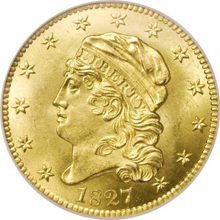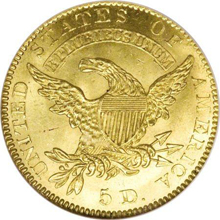 1827 $5 MS66 NGC. Breen-6486, BD-1, High R.5. The gold half eagles of the 1820s are among the most legendary rarities in U.S. numismatics. Although many collectors--even those who will never dream of owning an example of the type in any grade, much less Premium Gem MS66, as here--are to one degree or another intuitively aware of the extremely elusive nature of these near-mythic type coins, a more-analytical approach will serve to demonstrate just how truly uncommon they are.
1827 $5 MS66 NGC. Breen-6486, BD-1, High R.5. The gold half eagles of the 1820s are among the most legendary rarities in U.S. numismatics. Although many collectors--even those who will never dream of owning an example of the type in any grade, much less Premium Gem MS66, as here--are to one degree or another intuitively aware of the extremely elusive nature of these near-mythic type coins, a more-analytical approach will serve to demonstrate just how truly uncommon they are.
Perhaps as good a place as any to begin is with a short quotation from the indispensable Bass-Dannreuther Early U.S. Gold Coin Varieties: A Study of Die States 1795-1834:
"There is no [other] denomination of United States coins that boasts six unique varieties among its various types. ... Although the 1822 issue is the rarest date among early half eagles, there are six unique varieties among the other dates from 1795 to 1834! This coin [the 1828/7 Reverse of 1828, BD-2] is unique and is joined in its uniqueness by the 1797 Small Eagle (BD-4), the 1795 Large Eagle (BD-13), the two 1797 Large Eagles (16 and 15 Star obverses, BD-5 and BD-6), and the final half eagle, the unique 1834 Crosslet 4 Motto (BD-4) coin in the Bass core collection." (Bass-Dannreuther, p. 405.)
 While the snippet above deals with the early denomination as a whole among its various types, it does set the stage for the following comparison of the various half eagle dates in the 1810s and 1820s, hopefully leading to a better appreciation of their relative rarities and a keener understanding of the elusiveness of the 1820s dates in particular. All of the following data are based on those set forth in the Bass-Dannreuther reference.
While the snippet above deals with the early denomination as a whole among its various types, it does set the stage for the following comparison of the various half eagle dates in the 1810s and 1820s, hopefully leading to a better appreciation of their relative rarities and a keener understanding of the elusiveness of the 1820s dates in particular. All of the following data are based on those set forth in the Bass-Dannreuther reference.
The eight half eagle dates issued from 1810 to 1819 collectively embrace 17 different BD varieties that range from a couple of "common" R.2 variants--1813 BD-1, ofwhich 450-650 coins are known, and 1810 BD-4, of which 500-750 examples are known--up to the extremely rare or R.7 BD-1 of 1815, the only known variety for the year with an estimated population of 12 to 14 pieces surviving. For the eight 1810-1819 issues taken as a whole, Bass-Dannreuther estimates that from 2,358 to 3,340 pieces are known, making the average rarity of an 1810-1819 half eagle, irrespective of variety, about R.3, or from 295 to 418 pieces extant.
By comparison, the 10 half eagle issues dated from 1820 to 1829 comprise 25 varieties, ranging from the R.4 or very scarce 1823 BD-1, with an estimated surviving population of 80-100 pieces, to 18 varieties that are ranked either R.6 (very rare), R.7 (extremely rare), or R.8 (unique or nearly so). According to Bass-Dannreuther, the total survival for all 1820s-dated half eagles is a known population estimated at 375-476 pieces. To extend the comparison a step further, the average rarity of an 1820s half eagle of any date, irrespective of variety, is roughly high R.5, or 38-48 pieces known. Given that there are 25 varieties known for the decade, the average rarity of any 1820s variety is high R.6 (very rare), or about 15-19 pieces known. But probably the most stunning statistic regarding the relative rarities of the two decades is that there are about as many survivors of the entire decade of the 1820s--combined--as of any single typical date among the 1810s-dated issues. In other words, the typical 1820s-dated half eagle is roughly seven times as rare, again irrespective of variety, as the average 1810s-dated piece.
Of course, leading the parade, as a date, is the fabulous 1822 half eagle, of which only three pieces are extant today, as all experienced gold collectors know. Two specimens of the 1822 half eagle are in the Smithsonian Institution, one of them a resident of the Mint Cabinet since the 1850s, the second a part of the 1968 donation of Josiah K. Lilly. The 1825/4 BD-2 variety is even more elusive (all 1825 half eagles are 1825/4 overdates, but there are two different varieties) than the 1822, with but two pieces known.
In descending order of rarity, the next rarest dates in the 1820s are 1821, 1829, 1828, and 1825. The 1824, 1826 BD-1, and 1827 are virtually tied at sixth- to eighth-rarest (and all high R.5), with the 1823 and 1820 rounding out the decade as the "most (nearly) common" issues--these last two still in the range of very scarce to rare.
For the 1827 issue, Bass-Dannreuther records 22 auction appearances for the date between 1990 and 2005. However, at Heritage this is the finest piece, by several grade points, of this rare issue that we have ever had the privilege to offer. The date is evenly spaced and about centered, and star 13 all but touches the lowest hair curl. The reverse is that of the 1826 BD-2, which shows the top of the second E in STATES minutely higher than the adjacent T, and the top of the 5 is decidedly higher than the D in the denomination. The period after the D is spherical and flattened at both ends. The surfaces are bright yellow-gold, with radiant luster and a bold strike. As expected for the grade, surface abrasions are virtually non-existent, and Liberty's cheek and the obverse fields are exceptionally clean. A couple of ticks on the reverse below the N in UNUM will serve as future pedigree identifiers, as will a small, straight line from a planchet streak between the I in UNITED and the eagle's left (facing) wing. This piece is not only fundamentally rare, it is also conditionally an incredible rarity, as the finest and only MS66 certified for the issue. The highest piece at PCGS is a single MS65 coin. Census: 1 in 66, none finer (3/07).(Registry values: P6) (#8136)